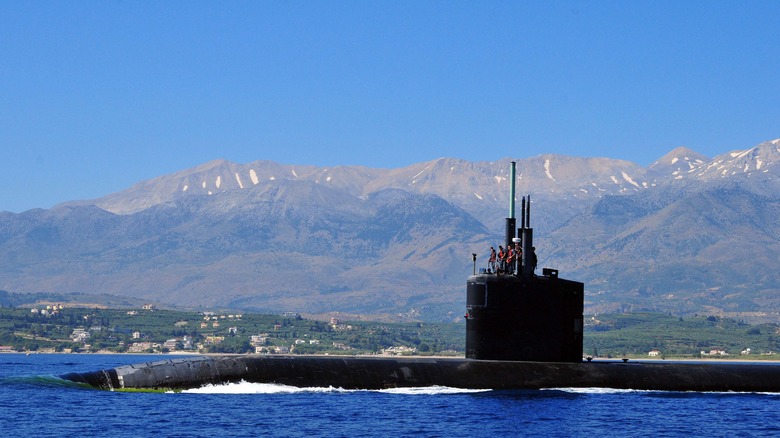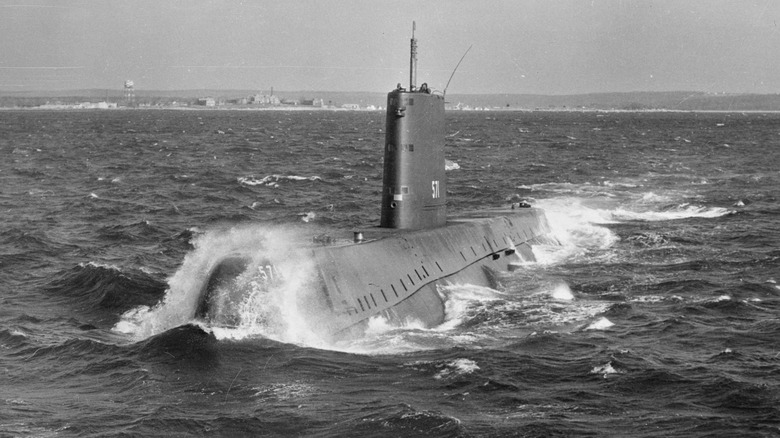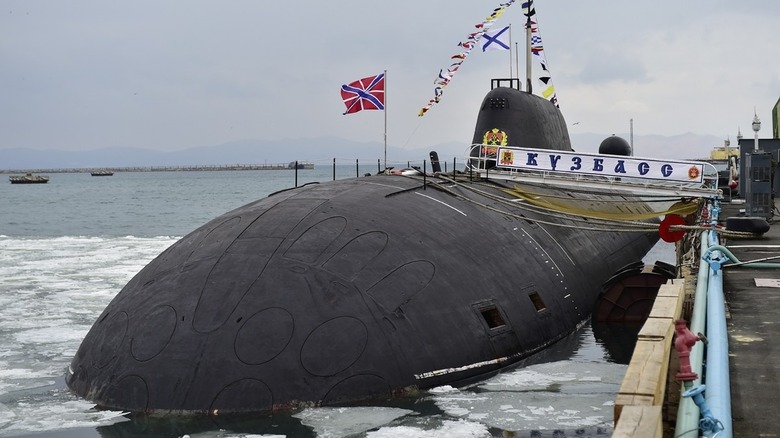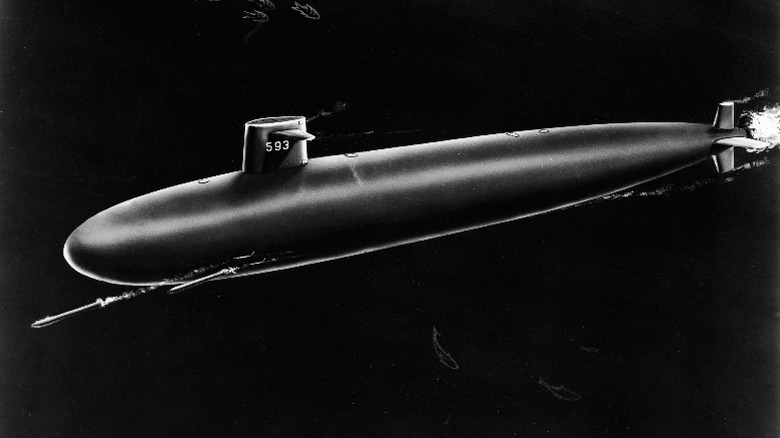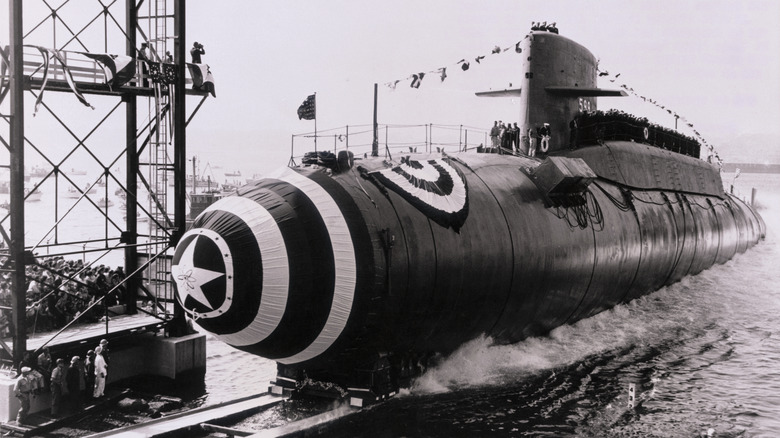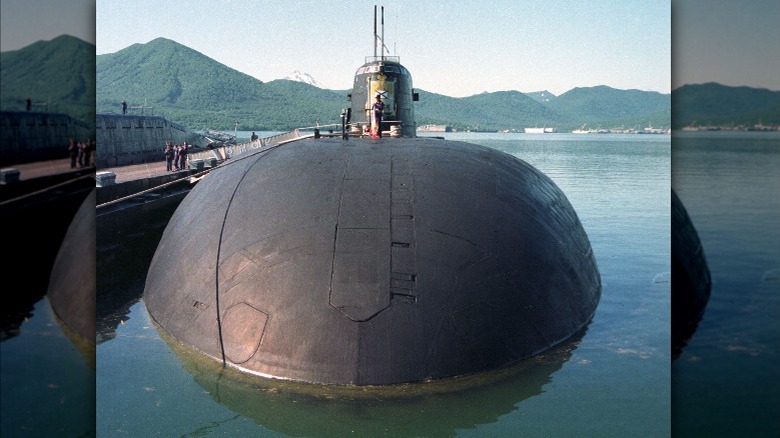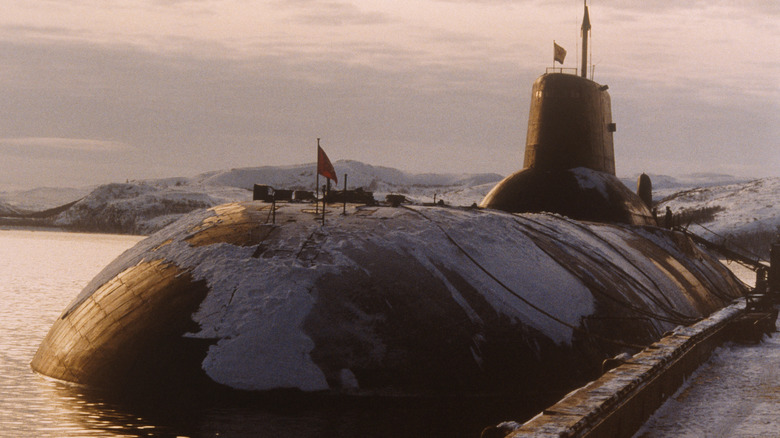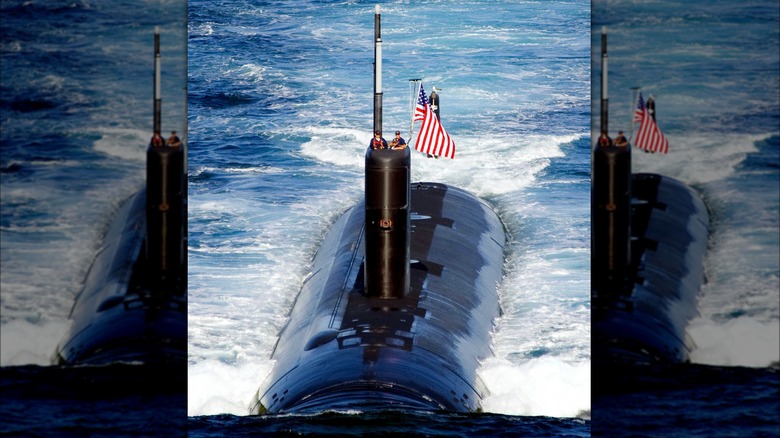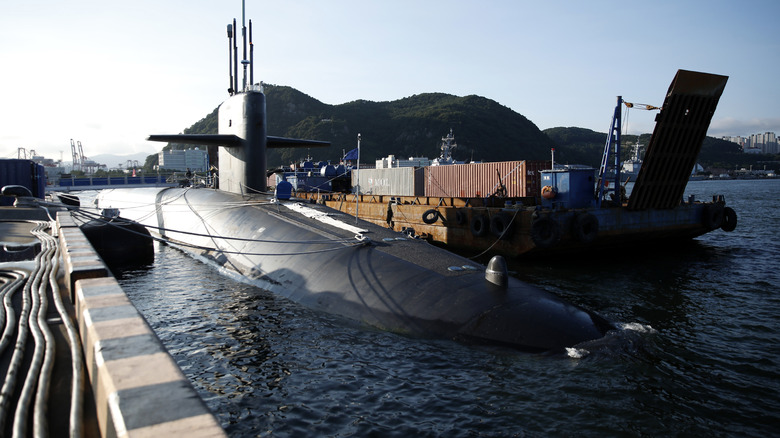The 8 Best Submarines From The Cold War Era, Ranked
The Cold War was a dark time. It began shortly after World War II and officially ended with the fall of the Soviet Union on December 26, 1991. Soon after the Cold War began, for the first time in history, humankind had the unfathomable power to potentially destroy the world. When most people think of the Cold War, they think about nuclear weapons, the Cuban Missile Crisis, and Mutually Assured Destruction. If you were a child during those times, you'd recall emergency broadcast tests and duck-and-cover drills in school, which were little more than a placebo.
The idea of reducing the Earth to a nuclear wasteland was horrifying and galvanized the world, but without an invincible first-strike capability, the specter of a nuclear wasteland was thankfully less likely. In 1959, nuclear ballistic missile submarines, later nicknamed boomers, gave us that invincible first-strike capability. The deployment of boomers and their nemesis, fast attack submarines, began a cat-and-mouse war game that changed naval warfare and made the world a far more dangerous place.
The term for these military engagements was anti-submarine warfare (ASW). The players in these undersea war games were many different classes of submarines. Some of them carried ballistic nuclear missiles that could, at close range, reach their targets in as little as ten minutes with zero hope of interception. Other subs, which carried anti-submarine weapons and sensitive detection systems, were stealthy and fast hunters of those merchants of death. Here are the best of each of these types, ranked.
8. USS Nautilus
This first entry on the list is more of an "Honorable Mention" than it is a competitor with the rest — no list of the best Cold War subs would be complete without the first nuclear-powered submarine ever built, the Nautilus. This sub was totally unique in the world at its time and was the only sub of its class ever built. For the American public, it was as if the submarine from Jules Verne's "Twenty Thousand Leagues Under the Sea" had sailed off the pages of a science fiction novel and into the real world.
Launched in January 1954, the Nautilus was larger than any diesel-electric boat that came before it. Though only a fully armed prototype, it proved to be the fastest, highest endurance, and deadliest sub of its day. Beyond that, it showed the US Navy the future of sea warfare and changed the course of world history. The Nautilus easily dominated every NATO exercise in which it fought. There was simply nothing like it.
The Nautilus achieved many firsts, including being the first vessel to traverse the North Pole by going under its icecap on August 3, 1958. This dangerous voyage was done partially in response to the Soviet launch of Sputnik 10 months earlier. The voyage was codenamed Operation Sunshine, and it took three attempts. Nautilus's ultimate success was made possible by another first, the installation of an inertial guidance system in a submarine. The Cold War would have been far different without the technological achievements that the Nautilus brought to submarine warfare.
7. Project 971 Akula Class
The Akula Class was a fourth generation nuclear-powered attack submarine that provided the Soviet's answer to the USN Los Angeles Class fast attack sub. The Akula entered service in 1986, ten years after the Los Angeles Class first appeared on the Cold War scene.
While the top speeds of submarines are highly classified, the Akula was believed to have a top speed of 33 knots. This made it faster than the Navy's publicly declared speed for the Los Angeles Class, which was 25 knots. However, the Navy's published specs for their subs are far less than the reality, and the Los Angeles Class was likely as fast or faster than the Akula.
Still, it was not the speed of the Akula that made it one of the top subs of the Cold War. What got the Akula on this best subs list was its absence of sound. The Akula's low noise signature shocked the Western intelligence community and came close to matching the noise levels of early Los Angeles Class subs — although it still wasn't in the same league as the improved Los Angeles Class, which had been deployed years earlier.
With the Akula's less sophisticated passive sonar, it was believed that tailing super-quiet USN boomers would be unsuccessful. It now seems likely that Akula subs did play cat-and-mouse with some boomers, and the Akulas used something other than sonar. Declassified reports suggest the Soviets tailed earlier classes of USN boomers by detecting its wake from a combination of clues that included pressure differentials and traces of chemicals that the boomer left behind.
[Featured image by Источник — VL.ru via Wikimedia Commons | Cropped and scaled | CC BY-SA 4.0]
6. Permit Class
The Permit Class nuclear-powered submarine was deployed in 1961. They were the first submarines designed explicitly for hunting and killing nuclear subs. The US Navy appears to have decided that a boat going over 30 knots was dangerously noisy. As a result, they focused instead on depth and stealth. Still, the Permit Class was no slouch, with a published top speed of 28 knots. It's likely the USS Thresher, the first Permit Class sub, was much faster than the Navy's published speed, as unofficial recollections from the crew of the Thresher claim a top speed of 33 knots.
To squeeze maximum efficiency out of its reactor and every turn of its propeller, the Permit Class had the smallest sail ever fitted on a US nuclear submarine. The sail — also called a conning tower — was a prime source of water resistance that seemed like an excellent candidate for trimming. This trimming turned out to be a questionable compromise. At periscope depth, the sail of the sub was too close to the surface, which led to accidental broaching — a major problem for a stealthy hunter.
For a time, Permit Class subs were the undisputed lone wolf predators of the seas. They carried a complement of non-nuclear weapons, including advanced high-speed torpedoes and Harpoon anti-ship missiles. By the late 1960s, they also carried nuclear UUM-44 short-range anti-submarine missiles. However, early on, the Permit Class suffered a terrible loss. In 1963, after three years of service, the USN Thresher was lost with every soul onboard during a supposedly routine dive test. Despite this tragedy, most of the remaining Permit Class subs went on to serve through the end of the Cold War.
5. George Washington Class
The USS George Washington was deployed in December 1959. It was 382 feet long and displaced 6,000 tons. It could fire a devastating salvo of torpedoes from its six tubes. However, attacking ships and submarines was not its mission. The USS George Washington's mission was to keep its 16 Polaris missiles on the ready for a devastating strike against the USSR.
The USS George Washington was a Skipjack Class attack boat converted to launch the Navy's brand new Polaris ballistic missiles. In July 1960, USS George Washington sailed into the Cold War history books when it launched a Polaris SLBM while submerged in the Atlantic Missile Test Range and became the world's first nuclear-powered ballistic missile submarine. This boat changed everything and set the stage for a major escalation in the Cold War.
In 1960, for a brief time, George Washington Class subs were the only boomers prowling the seas and struck ice-cold fear into the heart of the USSR. In April 1961, nine months later, the USSR commissioned its first nuclear-powered boomer, Submarine K-19, the first of their Project 658 Class. The K-19 was later dubbed the Widow Maker when a nuclear reactor failure resulted in the death of nearly two dozen crew members.
4. Project 949 Oscar Class
When deployed in December 1980, the Oscar Class cruise missile attack submarine was the largest and heaviest armed sub of its type in the Cold War. Its weapon capabilities were only exceeded when Ohio Class boomers were converted to non-nuclear cruise missile platforms after the Cold War ended.
Along with other formidable weapon systems, the Oscar Class carried two dozen SS-N-19 cruise missiles, which have a range of 388 miles. These missiles could be armed with either conventional high explosives or 350-kiloton nuclear warheads. These were not torpedo tube-launched weapons, as each missile was contained in its own vertical launch tube, which made near simultaneous firing of all 24 missiles possible. A salvo of these missiles could be fired while submerged, skim the waves hundreds of miles, and strike a target with little to no advanced warning.
The Oscar Class submarine posed a serious threat to US Navy carrier battle groups as well as coastal targets. A single 350-kiloton nuclear explosion generates a quarter-mile-wide fireball that would totally destroy any warship within it and potentially critically damage anything floating above the waterline within a blast radius of several miles. At over 500 feet in length and displacing over 16,000 tons, the Oscar Class was the opposite of a fast-attack sub. It submerged slowly and handled poorly. Its purpose was to be the bruiser in the bar fight that could deliver single-punch knockout blows.
3. Project 941 Typhoon Class
The USSR Typhoon Class – officially Project 941 — was an undersea leviathan that rattled the world. The first Typhoon was deployed in 1981. At 574 feet long, 79 feet wide, and 48,000 tons, they remain the largest submarines ever created and even provided the inspiration for the enemy boat immortalized by Tom Clancy in "The Hunt For Red October."
Typhoons employ a totally unique five-hull design that was needed to support the boat's truly massive 85-ton nuclear ballistic missiles, the largest SLBMs in the world. Unlike all other ballistic missile submarines, the Typhoon's 20 missile silos sit in front of its oversized sail as if to make the point that one of these war machines could almost singlehandedly crush Western civilization.
Each of the Typhoon's 20 SLBMs carried a MIRV (Multiple Independently Targetable Reentry Vehicles) payload of 10 warheads. This means that a single Typhoon Class submarine had the ability to simultaneously hit 200 different cities with warheads that delivered significantly more destructive force than the Hiroshima bomb. This kind of power is beyond human comprehension and should be beyond human hands. Thankfully, the last Typhoon was decommissioned in 2023.
2. Los Angeles Class
The Los Angeles Class nuclear-powered sub was the apex Cold War predator. Its primary mission was waging anti-submarine warfare to protect the Navy's carrier battle groups. Most of the missions of these submarines remain highly classified, but from what has been declassified, it's clear they also had another possibly more important task — shadowing Soviet boomers and standing ready to destroy them.
When the first of these ships were commissioned in 1976, they were the quietest attack boats ever developed and so advanced that many Los Angeles Class submarines remain in service today. Subsequent upgraded versions of the sub have been reported to be ten times quieter than the first. According to the U.S. Department of Defense, the top speed of a Los Angeles Class sub is over 25 knots. Though its actual maximum speed is classified, a top speed of 37 knots has been credibly reported. If accurate, this also makes the Los Angeles Class one of the fastest attack subs of its time.
Each iteration of the Los Angeles Class was equipped with a more advanced computerized passive sonar system than the prior version. Right from the start, its highly advanced passive sonars enabled these hunters to locate and shadow their submerged and surface prey like a bloodhound on an acoustic scent. When it came time to pounce, the Los Angeles Class was armed with a mix of weapons that included as many as 12 vertical launch Tomahawk cruise missiles that could carry a nuclear warhead and skim the waves for a thousand miles.
1. Ohio Class
During the Cold War, the job of a boomer was to run quiet, deep, and hidden. A key strategy was to sneak in as close to the enemy shoreline as possible and wait for orders to launch a nuclear attack. What set the Ohio Class above other Cold War subs was its stealth and endurance. Though information about these boats remains top secret, the Ohio Class is said to emit less noise than the background sounds of the ocean. It was without a doubt the quietest war machine in those Cold War seas, and today remains one of the quietest subs ever built. In military circles, it's said that when an Ohio Class sub goes deep and slow, even the US Navy cannot locate it.
Each Ohio Class boomer was armed with up to 24 Trident-II SLBMs that carried up to eight MIRV warheads each, for a total of 160 warheads. Each reentry vehicle contained up to a hydrogen bomb that could hit a target 4,000 miles away with unprecedented accuracy and enough power to turn a city the size of New York into something unimaginably worse than Hiroshima.
A boomer lurking off the coast of its target could not surface or send up a buoy to receive orders without giving away its position. So, commands to launch were likely initiated using extremely low frequency (ELF) radio waves that could penetrate water to depths of over a thousand feet. Massive antennas were built on dry land to send these ELF signals, one of which was 84 miles in length. To receive these one-way ELF text messages, boomers had to trail a thousand feet or more of antenna wire behind them.
